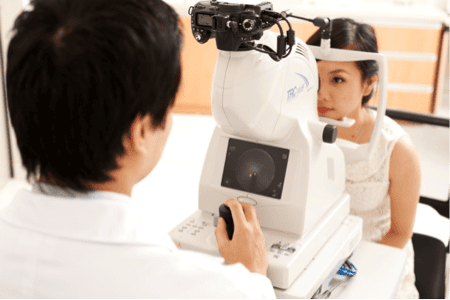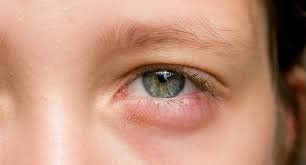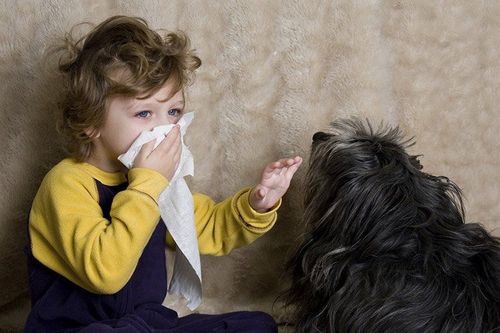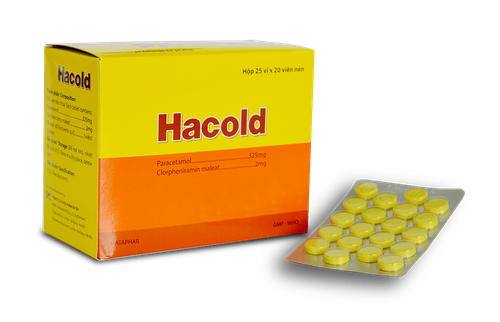This is an automatically translated article.
When suffering from skin allergies around the eyes or seasonal allergic eye inflammation, the patient needs to avoid contact with the triggers that cause the problem, use eye drops, anti-allergic drugs.1. Diagnosing eye allergies
When noticing symptoms of eye discomfort, such as allergies, swelling of the eyes, swelling of the lips, itchy eyes, and allergies, the patient should see a specialist for an accurate diagnosis and appropriate treatment. Your ophthalmologist will check to see if the symptoms are related to an eye infection or allergic conjunctivitis (redness of the eye). This condition can be diagnosed easily by examining your eyes and asking about your medical history, including both the patient's and the patient's family history.
To evaluate for signs of an eye allergy, the ophthalmologist will examine the eye with a slit lamp microscope, at the swollen blood vessels on the surface of the eye. If the allergy is severe or cannot be clearly seen, the doctor will choose to test for a specific type of white blood cell that occurs in the areas of skin around the eyes (called eosinophils) where the reaction occurs. allergy. This test is done by gently removing a small area of tissue from the conjunctiva and checking for eosinophils.

Chẩn đoán dị ứng mắt tại bệnh viện uy tín
2. Treatment of eye allergies without drugs
2.1. Rinsing the eyes When having an eye allergy, the first treatment to do is to wash the eyes with cold water, physiological saline or artificial tears. Cold compress is also an effective method to reduce allergies, eye swelling, lip swelling, eyelid edema, relieve itching and irritation, and stabilize cell membranes. Patients should pay attention to avoid touching their eyes, rubbing or pressing their eyes with their hands.
2.2 Avoiding allergens The treatment for eye allergies is to avoid and limit your exposure to the problem triggers. However, in many cases, the cause of the allergy cannot be identified. If necessary, an allergist can conduct a skin test or have the patient do a blood test to determine what a specific allergen is.
If pollen is the cause of an allergy, the patient should avoid going outside as much as possible at times when pollen counts are highest (usually mid-morning and evening) and when strong winds blow pollen to the environment. When outdoors, wear sunglasses to prevent pollen from entering your eyes and causing allergies.
To limit eye inflammation, allergies, weather caused by exposure to the air and wind that brings pollen and other irritants into the house, should close the door and use the air conditioner, air purifier, even when in the house. in the car. Do not use ventilation fans as their mechanism can draw pollen and allergens into the room. Periodically clean the air conditioning equipment.
In the case of skin allergies around the eyes caused by fungi, keep the humidity in the house low (about 30 - 50%). High humidity is a favorable condition for mold growth. Periodically clean high-humidity areas in your home, like basements, bathrooms, and kitchens, considering using a dehumidifier in particularly humid or humid places (like basements).
If dust is the cause of eye allergies, find ways to limit your exposure to dust, especially in the bedroom. Cover bedding, pillows, and blankets when not in use to reduce the risk of dust coming into contact with the skin. Regularly wash bed sheets, change pillowcases and clean blankets. When cleaning the floor, instead of using a broom, use a damp rag or towel to prevent dust from flying into the air, which can easily cause eye allergies.
Many patients are allergic to domestic animals. In this case, try to keep pets outside the house as much as possible. Do not allow pets in the bedroom and the area around the bed to prevent pet hair from clinging to pillows and blankets. Consider redecorating the floor with hardwood or tile instead of carpet, to prevent pet hair from getting in. Always wash your hands after petting a pet, and change clothes if you have been in contact with a pet. The most effective prevention is not keeping a pet.

Hạn chế tiếp xúc với bụi, nấm mốc đặc biệt là trong phòng ngủ
2.3 Treatment of Eye Allergies with Medicines Artificial Tears Artificial tear drops provide temporary relief of eye allergies as the allergens are washed away. At the same time, this eye drop also relieves dryness, reducing eye irritation by increasing moisture in the eyeball. Artificial tears can be purchased without a prescription and are used as often as needed.
Decongestants (with or without antihistamines) Decongestants relieve skin allergies around the eyes. In addition, the drug also works to clear the nose, prevent nasal congestion, allergic rhinitis, difficulty breathing.
Oral Antihistamines Oral antihistamines can be helpful in reducing allergies, eye swelling, and lip swelling. However, there are some side effects to watch out for, as they can cause dry eyes and even make eye allergy symptoms worse.
Antihistamine eye drops, mast cell stabilizer Eye drops contain two drugs with antihistamine action to relieve itching and stabilize mast cells to help prevent the risk of eye allergies. Depending on the condition, your doctor will prescribe the right eye drops, used once or twice daily to relieve itching, watering, redness and burning of the eyes.
Corticosteroid eye drops Eye drops with the active ingredient corticosteroids help treat symptoms of severe and chronic eye allergies, including itching, redness, and swelling.
Immunotherapy injections If allergy symptoms cannot be controlled by allergen avoidance, eye drops, and oral medications, your doctor will consider immunotherapy (allergen injections) to trigger a reaction that reduces eye allergies. With immunotherapy, a small amount of an allergen is introduced into the body by injection, with the dose increasing over time. The mechanism of this therapy helps the patient's body become immune to allergens.
When there are signs of skin allergy around the eyes, eye swelling, pain, redness, the patient should not be subjective. Early detection and treatment will help the eyes quickly return to health, and at the same time avoid the unfortunate consequences that can happen to the eyes.
Eye Unit of the Department of Eye, Ear, Nose, Throat and Maxillofacial Department, Vinmec International General Hospital has the function of comprehensive eye and vision health care for children, adults and the elderly including children, adults and the elderly. check for refractive errors, physical examination, diagnostic ultrasound, laser treatment and surgery. In addition, the Eye Unit also has the task of coordinating with other clinical departments in the treatment of pathological complications and eye injuries, including eye allergies.
Please dial HOTLINE for more information or register for an appointment HERE. Download MyVinmec app to make appointments faster and to manage your bookings easily.













